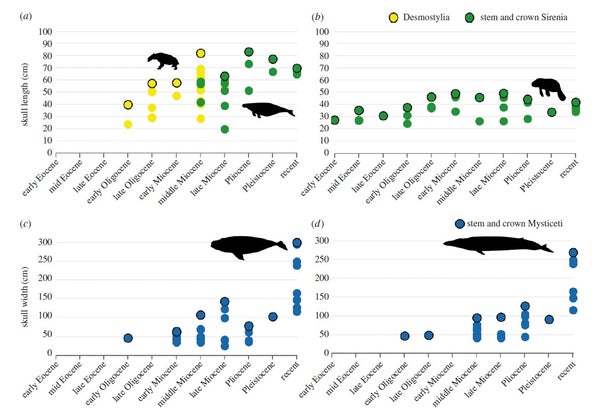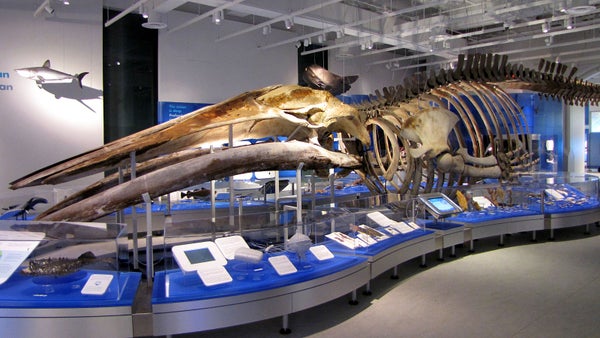This article was published in Scientific American’s former blog network and reflects the views of the author, not necessarily those of Scientific American
Life is supposed to have been bigger in the past. Millipedes as big as you crawled through the undergrowth in the oxygen-rich days of the Carboniferous, dinosaurs stretching over 120 feet long stomped around during the Cretaceous, and the largest land mammal of all time, Paraceratherium, browsed from tall trees during its Oligocene run of 34 to 23 million years ago. But this is just cherry picking based on our fascination with superlative size. Huge representatives of this or that lineage have popped up at different times for various reasons, and any appearance of life's diminution over time is an illusion compounded by the fact that much of the world's terrestrial megafauna was swept out at the close of the last Ice Age. In fact, some forms of life are bigger now than they've ever been before. Some of the largest animals to swim through our modern seas are far larger than their prehistoric counterparts.
Around 55 million years ago, as mammals were evolving into a fantastic array of forms, some beasts began to slip into the seas. These included the ancestors and relatives of today's whales and sea cows, as well as oddballs like the desmostylians (think of a cross between a seal and a hippo). The earliest of these pioneering mammals were small - the ancestral whale was about the size of a mouse deer - and this not only raises the question of when marine mammals started living large, but what that says about the ability of the seas to support such giants. To find out, paleontologists Nicholas Pyenson and Geerat Vermeij took a big picture view of marine mammals body size in the Atlantic and Pacific Oceans during the Age of Mammals.
Pyenson and Vermeij focused their attention on two different guilds of marine mammals - big herbivores such as sea cows and the desmostylians, as well as the filter-feeding mysticete whales. The different menus these marine mammals munched on seem to mark an neat split in their histories.

Maximum body size for marine mammals over time. Credit: Pyenson and Vermeij 2016
The big herbivores, Pyenson and Vermeij explain, hit their maximum body size range very early in their history. (The only exception being the enormous Steller's sea cow and its close relatives, which lived between 2 million years ago an their annihilation in historic times.) And within this pattern, the researchers found that the sea cows of the Atlantic never reached the sizes of those in the North Pacific. Bigger bodies are a boon in colder waters, and, more importantly, the North Pacific was the birthplace of kelp. These fast-growing plants could cope with seagoing lawnmowers like Steller's sea cow, while the seagrasses of the Atlantic may have limited the size of its manatees.
Filter-feeding whales show a different pattern. Compared to the leviathans we know today, many prehistoric baleen whales were puny. These whales stayed within a narrow size range up until about two million years ago, Pyenson and Vermeij write, when the ancestors and today's blue and right whales started to plump up. The onset of the Ice Age might have been the reason why. Baleen whales ballooned right when the world's glaciers expanded. "Together with continuing intense erosion and chemical weathering," Pyenson and Vermeij note, this "invigorated ocean circulation and productivity worldwide." In other words, it formed the basis for a plankton boom that opened up leviathan-scale body sizes that were impossible before. There could be no giants without a steady supply of the very small.
On supporting science journalism
If you're enjoying this article, consider supporting our award-winning journalism by subscribing. By purchasing a subscription you are helping to ensure the future of impactful stories about the discoveries and ideas shaping our world today.
Reference:
Pyenson, N., Vermeij, G. 2016. The rise of ocean giants: maximum body size in Cenozoic marine mammals as an indicator for productivity in the Pacific and Atlantic Oceans. Biology Letters. doi: 10.1098/rsbl.2016.0186
